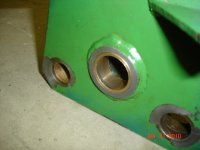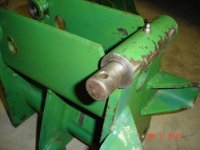Are you sure the old bushings are bronze rather than steel? The pressures on the bushings may exceed acceptable limits for bronze.
Commercially available thin wall bronze bushings are typically larger in both internal and external diameters than their nominal size. The bore into which the bushing is pressed is sized to give the desired inner diameter. Since the bushings are thin walled, they tend to shrink to fit the bore in which they are inserted. For example, a nominal 1.000" ID X 1.250" ID bushing with 0.125" thick walls might be (before installation) 1.002" ID X 1.252" OD. That's why it slides easily on a 1.000" rod. If pressed into a 1.251" bore, which is a 0.001" interference fit, the ID will shrink by about 0.001", giving a 0.001" running clearance, which is typical for oilite bronze bearings on a moderate speed shaft (electric motors, etc.).
But if the 1.252" OD oilite bushing is pressed into a 1.250" bore, then the ID shrinks by 0.002" to 1.000", which is a very tight fit on a true 1.000" OD pin.
Oilite bushing manufacturers recommend against sanding, drilling, or even reaming the installed bushing for various reasons. Sanding leaves grit in the pores, and drilling and reaming wipe the surfaces and close off the pores that carry oil to the bearing surface.
If the bushing is plain bronze rather than oilite, these procedures (sanding, drilling, reaming) should give acceptable results.


